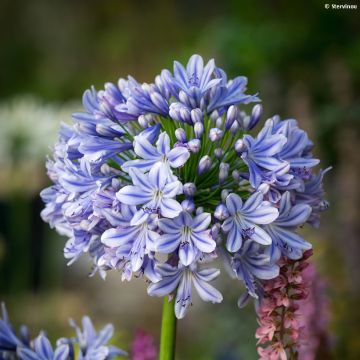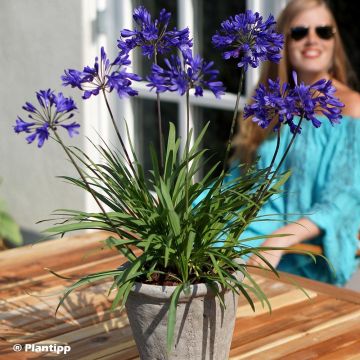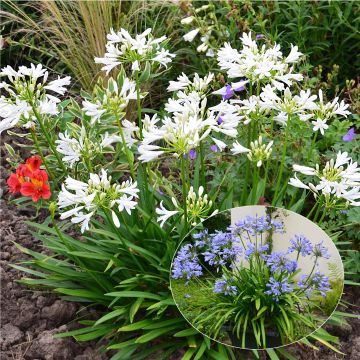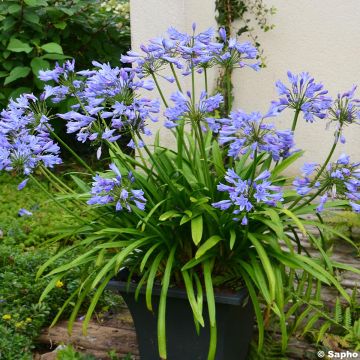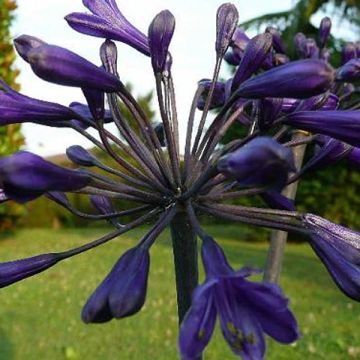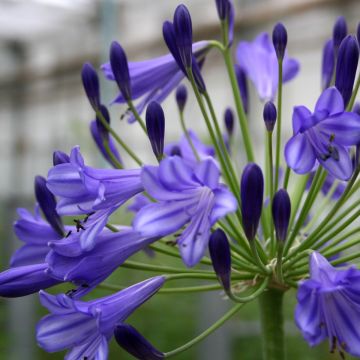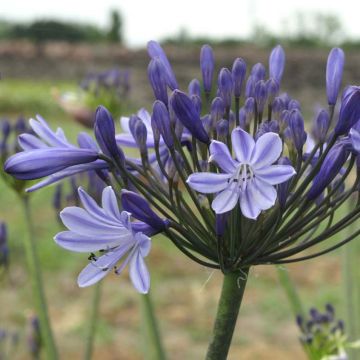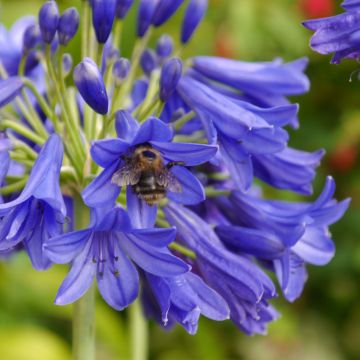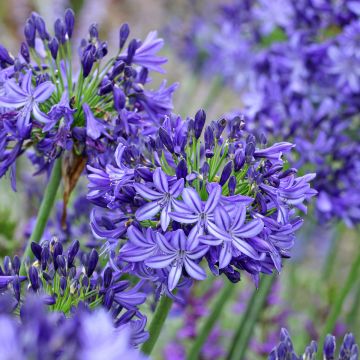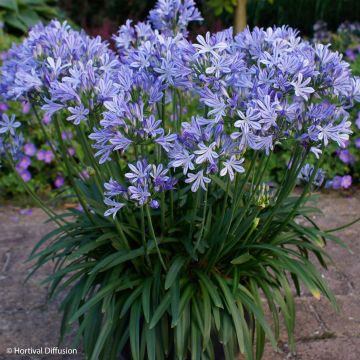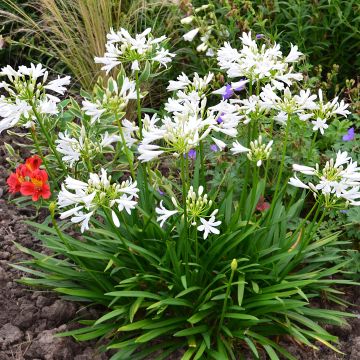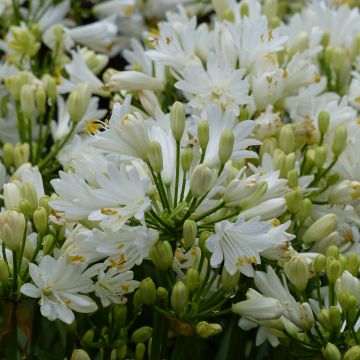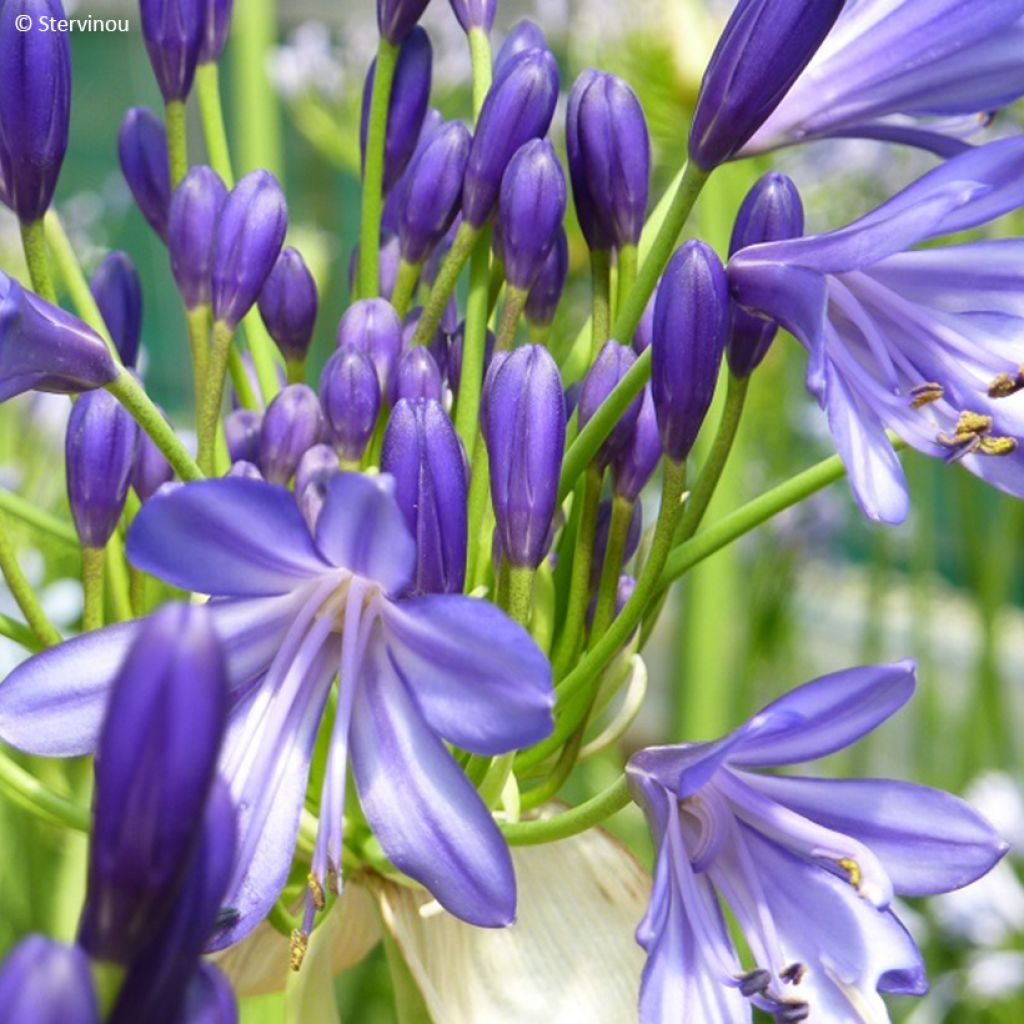

Agapanthus African Skies - African Lily
Agapanthus African Skies - African Lily
Agapanthus African Skies
African Lily, Lily of the Nile
Why not try an alternative variety in stock?
View all →This plant carries a 12 months recovery warranty
More information
We guarantee the quality of our plants for a full growing cycle, and will replace at our expense any plant that fails to recover under normal climatic and planting conditions.
From €5.90 for pickup delivery and €6.90 for home delivery
Express home delivery from €8.90.
Does this plant fit my garden?
Set up your Plantfit profile →
Description
The Agapanthus 'African Skies' is a sought-after variety for its large flowers and magnificent gentian blue colour. It is a very ornamental perennial plant that blooms remarkably generously throughout the summer. It adds a touch of exotic beauty to sunny borders and serves as a structural element on a terrace. Suited to mild climates, it retains its foliage in winter and its well-protected stump can withstand temperatures down to -7°C.
The Agapanthus 'African Skies' belongs to the Amaryllidaceae family, like all agapanthuses. It is a horticultural hybrid selected for its large, colourful flowers and its long and abundant flowering.
With an elegant appearance, this Agapanthus 'African Skies' forms a dense clump of linear, arched, glossy green leaves measuring about 40 to 50 cm long. Its flowering stems reach up to 90 cm in height, bearing spherical umbel inflorescences composed of many small trumpet-shaped flowers. These bright light blue flowers are 3 to 5 cm long. Each umbel measures 25 to 30 cm in diameter. The flowering period is from July to September. The theoretically evergreen foliage will be destroyed by frost below -5°C.
The rhizomatous roots of Agapanthus 'African Skies' enable it to withstand dry periods, although it prefers regular watering during the warm season. Its growth is moderately fast, reaching its adult size within a few years. This perennial requires well-drained soil, ideally enriched with organic matter, and thrives in full sun. It can tolerate temperatures down to -7°C, but must be protected or grown in a pot in regions with harsh winters.
The Agapanthus 'African Skies' is perfect for structuring borders or creating edging along pathways. Its slender stems and spectacular flowers bring verticality to all plant compositions. It blends perfectly in Mediterranean gardens, contemporary gardens, or even on urban terraces where it can be grown in a pot. When combined with other perennial plants, it creates stunning colour and texture contrasts. For a harmonious effect, it can be paired with grasses like Pennisetum 'Black Beauty' or perennials such as Gaura 'Rosy Jane'. It pairs well with agapanthuses of other colours like 'Black Pantha' for a strong contrast, or softer varieties like 'White Heaven'. In a flowerbed, the Daylily 'Stella de Oro' and the Salvia nemorosa 'Caradonna' are also beautiful companions, offering complementary flowering periods.
Report an error about the product description
Flowering
Foliage
Plant habit
Botanical data
Agapanthus
African Skies
Amaryllidaceae
African Lily, Lily of the Nile
Cultivar or hybrid
Other Agapanthus - Lily of the Nile
Planting and care
Plant the Agapanthus stumps by covering them with at least 10 cm of good soil, this way they are more resistant to the cold. It is essential to plant them in spring and preferable to mulch them in winter in most of our regions. For pot cultivation, use 5 young plants for a 24 cm pot and shelter your pots in winter. They prefer a rich and moist, but well-drained soil, enriched with sand. Water them regularly during the growth period (twice a week). However, avoid watering them afterwards. They dread excess moisture in winter. This variety is hardy to around -7°C, it particularly thrives by the sea and in containers. Use a well-drained sandy, slightly acidic mix. This plant seems to prefer shallow, but wide containers, and will flower abundantly if regularly fed with a slow-release fertiliser.
Planting period
Intended location
Care
This item has not been reviewed yet - be the first to leave a review about it.
Haven't found what you were looking for?
Hardiness is the lowest winter temperature a plant can endure without suffering serious damage or even dying. However, hardiness is affected by location (a sheltered area, such as a patio), protection (winter cover) and soil type (hardiness is improved by well-drained soil).

Photo Sharing Terms & Conditions
In order to encourage gardeners to interact and share their experiences, Promesse de fleurs offers various media enabling content to be uploaded onto its Site - in particular via the ‘Photo sharing’ module.
The User agrees to refrain from:
- Posting any content that is illegal, prejudicial, insulting, racist, inciteful to hatred, revisionist, contrary to public decency, that infringes on privacy or on the privacy rights of third parties, in particular the publicity rights of persons and goods, intellectual property rights, or the right to privacy.
- Submitting content on behalf of a third party;
- Impersonate the identity of a third party and/or publish any personal information about a third party;
In general, the User undertakes to refrain from any unethical behaviour.
All Content (in particular text, comments, files, images, photos, videos, creative works, etc.), which may be subject to property or intellectual property rights, image or other private rights, shall remain the property of the User, subject to the limited rights granted by the terms of the licence granted by Promesse de fleurs as stated below. Users are at liberty to publish or not to publish such Content on the Site, notably via the ‘Photo Sharing’ facility, and accept that this Content shall be made public and freely accessible, notably on the Internet.
Users further acknowledge, undertake to have ,and guarantee that they hold all necessary rights and permissions to publish such material on the Site, in particular with regard to the legislation in force pertaining to any privacy, property, intellectual property, image, or contractual rights, or rights of any other nature. By publishing such Content on the Site, Users acknowledge accepting full liability as publishers of the Content within the meaning of the law, and grant Promesse de fleurs, free of charge, an inclusive, worldwide licence for the said Content for the entire duration of its publication, including all reproduction, representation, up/downloading, displaying, performing, transmission, and storage rights.
Users also grant permission for their name to be linked to the Content and accept that this link may not always be made available.
By engaging in posting material, Users consent to their Content becoming automatically accessible on the Internet, in particular on other sites and/or blogs and/or web pages of the Promesse de fleurs site, including in particular social pages and the Promesse de fleurs catalogue.
Users may secure the removal of entrusted content free of charge by issuing a simple request via our contact form.
The flowering period indicated on our website applies to countries and regions located in USDA zone 8 (France, the United Kingdom, Ireland, the Netherlands, etc.)
It will vary according to where you live:
- In zones 9 to 10 (Italy, Spain, Greece, etc.), flowering will occur about 2 to 4 weeks earlier.
- In zones 6 to 7 (Germany, Poland, Slovenia, and lower mountainous regions), flowering will be delayed by 2 to 3 weeks.
- In zone 5 (Central Europe, Scandinavia), blooming will be delayed by 3 to 5 weeks.
In temperate climates, pruning of spring-flowering shrubs (forsythia, spireas, etc.) should be done just after flowering.
Pruning of summer-flowering shrubs (Indian Lilac, Perovskia, etc.) can be done in winter or spring.
In cold regions as well as with frost-sensitive plants, avoid pruning too early when severe frosts may still occur.
The planting period indicated on our website applies to countries and regions located in USDA zone 8 (France, United Kingdom, Ireland, Netherlands).
It will vary according to where you live:
- In Mediterranean zones (Marseille, Madrid, Milan, etc.), autumn and winter are the best planting periods.
- In continental zones (Strasbourg, Munich, Vienna, etc.), delay planting by 2 to 3 weeks in spring and bring it forward by 2 to 4 weeks in autumn.
- In mountainous regions (the Alps, Pyrenees, Carpathians, etc.), it is best to plant in late spring (May-June) or late summer (August-September).
The harvesting period indicated on our website applies to countries and regions in USDA zone 8 (France, England, Ireland, the Netherlands).
In colder areas (Scandinavia, Poland, Austria...) fruit and vegetable harvests are likely to be delayed by 3-4 weeks.
In warmer areas (Italy, Spain, Greece, etc.), harvesting will probably take place earlier, depending on weather conditions.
The sowing periods indicated on our website apply to countries and regions within USDA Zone 8 (France, UK, Ireland, Netherlands).
In colder areas (Scandinavia, Poland, Austria...), delay any outdoor sowing by 3-4 weeks, or sow under glass.
In warmer climes (Italy, Spain, Greece, etc.), bring outdoor sowing forward by a few weeks.




































